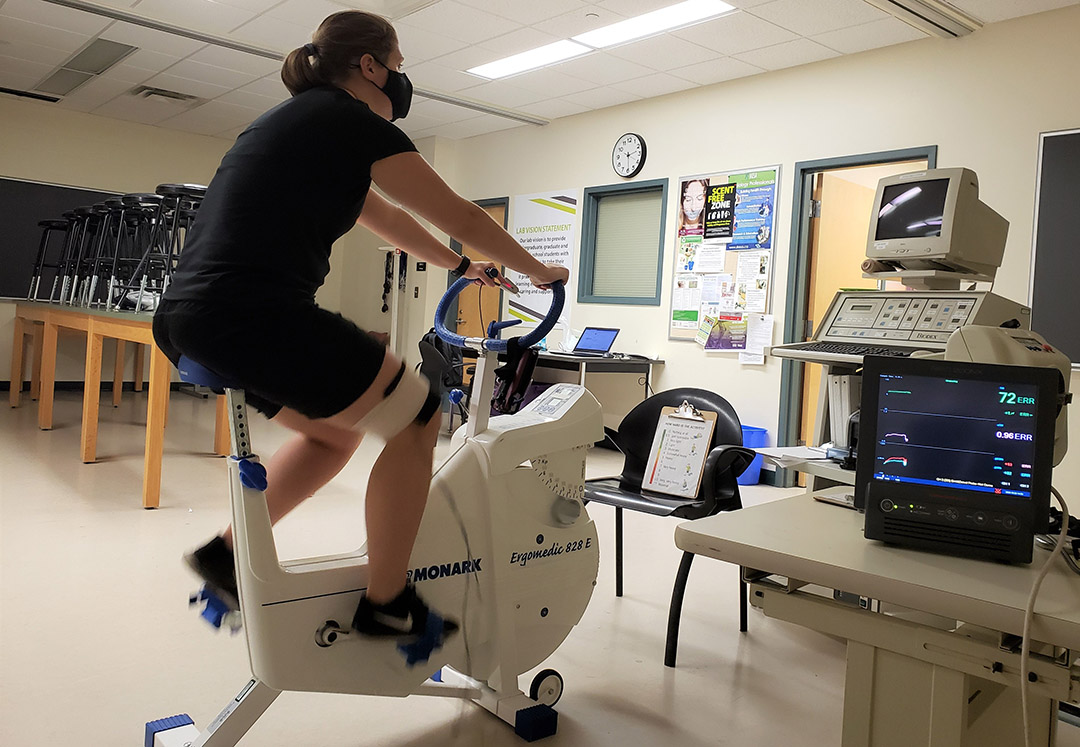
New kinesiology research: Masking up for physical fitness
A new study by researchers in the College of Kinesiology has determined that exercise performance and blood and muscle oxygen levels for healthy individuals are not affected by wearing a face mask during workouts.
By Alyssa Wiebe | Kinesiology Communications
Keely Shaw is a first-year kinesiology PhD student at the University of Saskatchewan (USask) and a high-performance athlete who was involved in the study. From lacing up her skates on the ice, to competing in the Para-cycling World Championships, Shaw has had to perform under the most strenuous circumstances, which made her the perfect fit to participate as an athlete and researcher in the study.
“I think it can be really beneficial for a researcher to take part in their own studies. It’s always good to have a better idea of what you are putting your participants through,” said Shaw. “By being a participant, it allows me to appreciate some of the grey area instead of focusing on only the black and white that is quantitative research outcomes.”
Some athletes have raised concerns about the comfort and ability to breathe while masked up, but the research has shown it has no detrimental effect on performance. Shaw agreed that the mask is a new piece of equipment that is a little discomforting, but she did not find it hard to breathe in while exercising.
“Having the mask cup my mouth on every inhale definitely was not comfortable, but that being said, I’ve done a few bike rides outside with a mask and it seems to be less of a discomfort every time,” she said. “I think it’s just something a person has to get used to.”
During the study, published Nov. 3 in the International Journal of Environmental Research and Public Health, seven male and seven female tested two different types of masks. The first was a disposable blue surgical mask and the second a three-layer cotton mask that is currently recommended by Dr. Theresa Tam (MD), Canada’s Chief Public Health Officer.
“I found the three-layer to be a bit more difficult to breathe in, I think just because it was thicker and warmer,” said Shaw, who took part in the study led by co-author Dr. Phil Chilibeck (PhD) along with Dr. Gordon Zello (PhD) of the College of Pharmacy and Nutrition, Dr. Scotty Butcher (PhD) from the School of Rehabilitation Science, and kinesiology alumnus John Ko.
Shaw performed bike tests that started out low impact while progressing steadily to high impact. She described it as “climbing a hill that got steeper every two minutes.” The formal test was 12 minutes long, plus an extra five minutes for a warm-up, all while donning a mask.
Some athletes have concerns that wearing a mask would affect their performance and while Shaw agrees there are some concerns, she doesn’t think it would take long to understand the benefits of using a mask while training.
“If you’ve never exercised in a mask, I think it would be hard to perform at first. If you use it in training though, I don’t think it would impact your performance all that much,” she said. “It might even improve your performance as it teaches you to breathe through your nose more instead of your mouth.”
As the global pandemic wears on, sport and recreation offerings are being questioned as many believe it is harder to limit the spread of COVID-19 during these activities. In order to keep these opportunities available in Saskatchewan, mask use was made mandatory while entering and exiting facilities, and most recently during exercise and competition.
“I believe masks should be mandatory in all areas of sport and recreation,” said Shaw. “We need our fitness facilities and sporting programs to stay open to help maintain our physical and mental health, especially as we enter the winter months. If this is a small action that we can do to keep them open, it would be foolish not to.”
Like many athletes, Shaw misses racing her bike, socializing with her teammates, and traveling the world. Her goal from 2020 remains the same heading into 2021 – competing in the 2021 Paralympics in Tokyo next August.
“Having it delayed for a year was disappointing, but it had to be done,” said Shaw. “I am just continuing to work hard to prepare and hoping for the best in 2021.”
